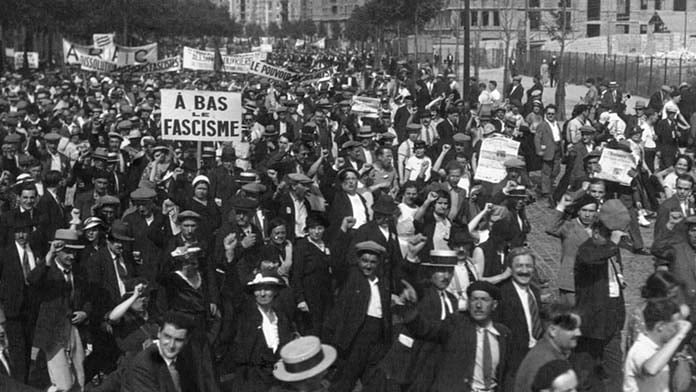The Popular Front against fascism in France in the 1930s weakened resistance and meant restraining one of the greatest workers’ upsurges in history, writes James Supple
Far right and fascist parties have made sweeping gains in recent elections across Europe—and now stand on the verge of entering government in a series of countries.
The AfD (Alternative for Germany) recently came first in the regional election in Thuringia and a close second in Saxony.
Austria’s fascist Freedom Party is leading in the polls for the upcoming general election on almost 30 per cent. Italy already has a fascist as Prime Minister.
And in the US, Donald Trump still has a real chance of taking back the Presidency in November.
Everywhere they are seeking to channel discontent in a racist direction, blaming refugees and migrants for the cost of living crisis.
Trump has pledged to deport between 15 and 20 million undocumented migrants. The Freedom Party in Austria says it wants to stop all asylum applications and enforce “remigration” to deport migrants back to where they came from.
How can they be stopped?
Recent parliamentary elections in France were hailed as a success in halting their advance.
Marine Le Pen’s National Rally (NR) is the most successful fascist party in Europe—and stood a chance of winning the election and forming government.
But it was eventually pushed into third place, after both the left-wing New Popular Front (NPF) and President Emmanuel Macron’s party in terms of seats.
The result has been seen as a success for the NPF and its strategy, which grouped together more moderate left parties like the Socialist Party and the far left France Unbowed.
The NPR struck an alliance with Macron’s party, where each party agreed to withdraw its candidate in constituencies where it was judged the other had a better chance of winning.
Electorally this had some success. But it creates big political problems.
The left agreed to stand aside for notorious government ministers from Macron’s party who have been responsible for savage attacks on pensions and the unemployed.
The fascists seized on this, declaring the left in league with Macron—and presenting itself as the only real opposition.
The alliance may have stopped the NR from winning the election. But NR still increased its vote by over six million, won its highest percentage of the vote ever and gained 53 seats. It remains within striking distance of power.
This approach, where the left allies with the political centre against the far right, is also being promoted in the US as a model for stopping Trump.
Democratic socialist Bernie Sanders wrote in the New York Times that, “It’s time to learn a lesson from the progressive and centrist forces in France” where, he said, “despite profound political differences” the left and centrists “came together to soundly defeat right wing extremism.”
Instead of building an independent left, figures like Sanders and Alexandria Ocasio-Cortez are using the idea that Trump’s election would mean the end of democracy in the US to corral the left into campaigning for the Democrats.
This means falling behind a party controlled by billionaires that is backing and arming Israel’s genocide in Gaza.
The 1930s
The French New Popular Front takes direct inspiration from the Popular Front government that came to power in France in the 1930s. This has become a popular model for the fight against fascism—yet the whole experience ended in disaster.
The 1930s saw the rapid growth of fascism in France in response to severe economic crisis. In February 1934 fascist groups organised a violent demonstration of thousands near the French parliament, following a corruption scandal. Police shot 17 people dead.
This was widely see as an attempt to overthrow the government and seize power. It led to the fall of the government and parliament appointing a more right-wing regime promising to impose law and order in its place.
Hitler had taken power in Germany just the year before. Now fascism looked to be coming in France too.
The events sent a shock through the working class movement. The fascist dictatorships in Italy, Germany and Austria had banned political parties and outlawed trade unions, sending working class activists to concentration camps.
In Germany, divisions between the two main workers’ parties had allowed the Nazis to take power without serious resistance. A similar situation existed in France, with the Communist Party pursuing a policy of vicious sectarian hostility to the Socialist Party, and the trade union movement also divided.
After the fascist demonstration, the Communist Party organised its own protest against fascism and refused offers to work with Socialist Party members. This saw it suffer a setback, with the police attacking the rally and killing six protesters.
On 12 February the Socialist Party backed a trade union strike rally. The Communists threw their support behind it at the last minute.
The action was a huge success, with four and a half million taking part. In Paris, the Communist Party and the Socialists organised separate rallies, both converging on the Place de la Nation square.
When the two marches met, one observer recorded that, “to the astonishment of the party and union leaders, this encounter triggered off a delirious enthusiasm, an explosion of shouts of joy. Applause, cries of ‘Unity, Unity’.”
Socialist leader Leon Blum explained that, “By a sort of popular groundswell the people’s will had imposed unity of action on the working class.”
This kind of unity in struggle was the key to halting the fascists’ advance. It could have led to a united front of the kind advocated by Leon Trotsky, the Russian revolutionary then in exile in France.
He argued for committees of action against fascism, to defend unions and the left against fascist organisation locally and to unite the working class in struggle.
Such unity in action could have allowed revolutionary workers to prove that struggle from below was the key to stopping fascism and to winning gains for workers.
Allying with ruling class parties
Instead the Communist Party, on the orders of Stalin in Russia, began looking for allies among the capitalist parties as a supposed defence against fascism.
Stalin wanted a military alliance between France and Russia against Hitler’s Germany, and used the Communist Party to further his foreign policy aims.
In an effort to secure such an alliance the Communists turned sharply to the right, promising to defend French military spending and the state and abandoning campaigns against colonialism.
The Popular Front was born as an electoral alliance including not just the working class parties but also the misnamed Radical Party, a middle class party that had frequently run government. Their involvement would drag the Popular Front to the right, forcing it to restrain strike action and limiting it to policies acceptable to the Radicals.
The consequences of this became clear as soon when the Popular Front swept to victory in the 1936 elections. With the country’s first ever Socialist Prime Minister, workers thought they finally had a government that was on their side.
In June 1936 the electoral victory triggered a massive wave of struggle. Over two million workers went on strike, with three-quarters of the strikes involving factory occupations.
As one historian put it, “the strikes spared almost no section of industry”, stretching “from Renault’s huge Billancourt plant with its 32,000 workers to tiny workshops, from the relatively highly unionised mines and docks to the totally un-unionised employees of department stores.”
Workers’ occupations, which saw them determinedly secure control of the workplaces against their bosses, seemed to carry the threat of expropriation. Trotsky argued that it signalled, “the French revolution has begun”.
Yet instead of trying to continue and deepen the struggle, the Popular Front government set out to derail the movement.
The Communist Party was instrumental in this. Its leader Maurice Thorez said that “we must know how to end a strike”. He even declared that “Not everything is possible now”.
Significant concessions were made in order to end the strikes, with the introduction of a 40-hour week, paid holidays and large wage rises.
But these gains would be quickly eroded as the economic crisis continued and the bosses went on the offensive.
The following year the Socialist Prime Minister Leon Blum was forced to resign in the face of pressure from business, and a Radical leader took his place.
The right grew in confidence and the Popular Front government collapsed completely in 1938.
When the new government re-imposed a six-day working week, renewed strikes against this were brutally repressed.
In 1940 the Nazis invaded and occupied France. It was the same parliament elected when the Popular Front came to power in 1936 that voted to install the collaborationist regime of Marshal Petain. It had already expelled Communist Party MPs, with their party banned.
The Popular Front shows why alliances with capitalist parties and sections of the ruling class against fascism are a dead end.
This remains true today. Official politics is in crisis all across the developed world.
Decades of austerity and attacks on workers as part of the neo-liberal offensive are hollowing out support for mainstream parties.
This has produced huge inequality, as the earnings and wealth of the rich have skyrocketed.
The major parties have again and again turned to racism to try to rebuild their support. This is only legitimising the far right.
Stopping the far right requires fighting the racism coming from both the political mainstream and the far right.
And it means building socialist organisation to fight for real improvement to workers’ wages, conditions and public services—and that isn’t afraid to target capitalism as a whole.





